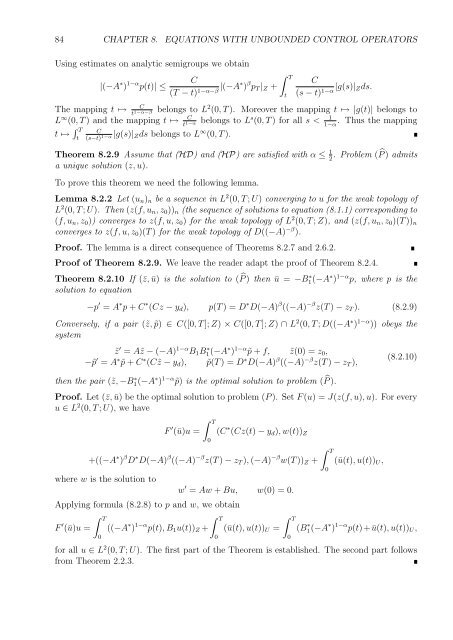Optimal Control of Partial Differential Equations
Optimal Control of Partial Differential Equations
Optimal Control of Partial Differential Equations
You also want an ePaper? Increase the reach of your titles
YUMPU automatically turns print PDFs into web optimized ePapers that Google loves.
84 CHAPTER 8. EQUATIONS WITH UNBOUNDED CONTROL OPERATORS<br />
Using estimates on analytic semigroups we obtain<br />
|(−A ∗ ) 1−α p(t)| ≤<br />
C<br />
(T − t) 1−α−β |(−A∗ ) β pT |Z +<br />
T<br />
t<br />
C<br />
|g(s)|Zds.<br />
(s − t) 1−α<br />
The mapping t ↦→ C<br />
t1−α−β belongs to L2 (0, T ). Moreover the mapping t ↦→ |g(t)| belongs to<br />
L∞ (0, T ) and the mapping t ↦→ C<br />
t1−α belongs to Ls (0, T ) for all s < 1 . Thus the mapping<br />
1−α<br />
t ↦→ T C<br />
t (s−t) 1−α |g(s)|Zds belongs to L∞ (0, T ).<br />
Theorem 8.2.9 Assume that (HD) and (HP) are satisfied with α ≤ 1<br />
2 . Problem ( P ) admits<br />
a unique solution (z, u).<br />
To prove this theorem we need the following lemma.<br />
Lemma 8.2.2 Let (un)n be a sequence in L 2 (0, T ; U) converging to u for the weak topology <strong>of</strong><br />
L 2 (0, T ; U). Then (z(f, un, z0))n (the sequence <strong>of</strong> solutions to equation (8.1.1) corresponding to<br />
(f, un, z0)) converges to z(f, u, z0) for the weak topology <strong>of</strong> L 2 (0, T ; Z), and (z(f, un, z0)(T ))n<br />
converges to z(f, u, z0)(T ) for the weak topology <strong>of</strong> D((−A) −β ).<br />
Pro<strong>of</strong>. The lemma is a direct consequence <strong>of</strong> Theorems 8.2.7 and 2.6.2.<br />
Pro<strong>of</strong> <strong>of</strong> Theorem 8.2.9. We leave the reader adapt the pro<strong>of</strong> <strong>of</strong> Theorem 8.2.4.<br />
Theorem 8.2.10 If (¯z, ū) is the solution to ( P ) then ū = −B ∗ 1(−A ∗ ) 1−α p, where p is the<br />
solution to equation<br />
−p ′ = A ∗ p + C ∗ (Cz − yd), p(T ) = D ∗ D(−A) β ((−A) −β z(T ) − zT ). (8.2.9)<br />
Conversely, if a pair (˜z, ˜p) ∈ C([0, T ]; Z) × C([0, T ]; Z) ∩ L 2 (0, T ; D((−A ∗ ) 1−α )) obeys the<br />
system<br />
˜z ′ = A˜z − (−A) 1−α B1B ∗ 1(−A ∗ ) 1−α ˜p + f, ˜z(0) = z0,<br />
−˜p ′ = A ∗ ˜p + C ∗ (C ˜z − yd), ˜p(T ) = D ∗ D(−A) β ((−A) −β z(T ) − zT ),<br />
then the pair (˜z, −B ∗ 1(−A ∗ ) 1−α ˜p) is the optimal solution to problem ( P ).<br />
(8.2.10)<br />
Pro<strong>of</strong>. Let (¯z, ū) be the optimal solution to problem (P ). Set F (u) = J(z(f, u), u). For every<br />
u ∈ L2 (0, T ; U), we have<br />
F ′ (ū)u =<br />
T<br />
0<br />
(C ∗ (Cz(t) − yd), w(t))Z<br />
+((−A ∗ ) β D ∗ D(−A) β ((−A) −β z(T ) − zT ), (−A) −β w(T ))Z +<br />
where w is the solution to<br />
w ′ = Aw + Bu, w(0) = 0.<br />
Applying formula (8.2.8) to p and w, we obtain<br />
F ′ (ū)u =<br />
T<br />
((−A<br />
0<br />
∗ ) 1−α T<br />
p(t), B1u(t))Z +<br />
0<br />
(ū(t), u(t))U =<br />
T<br />
0<br />
(ū(t), u(t))U,<br />
T<br />
(B<br />
0<br />
∗ 1(−A ∗ ) 1−α p(t)+ū(t), u(t))U,<br />
for all u ∈ L 2 (0, T ; U). The first part <strong>of</strong> the Theorem is established. The second part follows<br />
from Theorem 2.2.3.

















